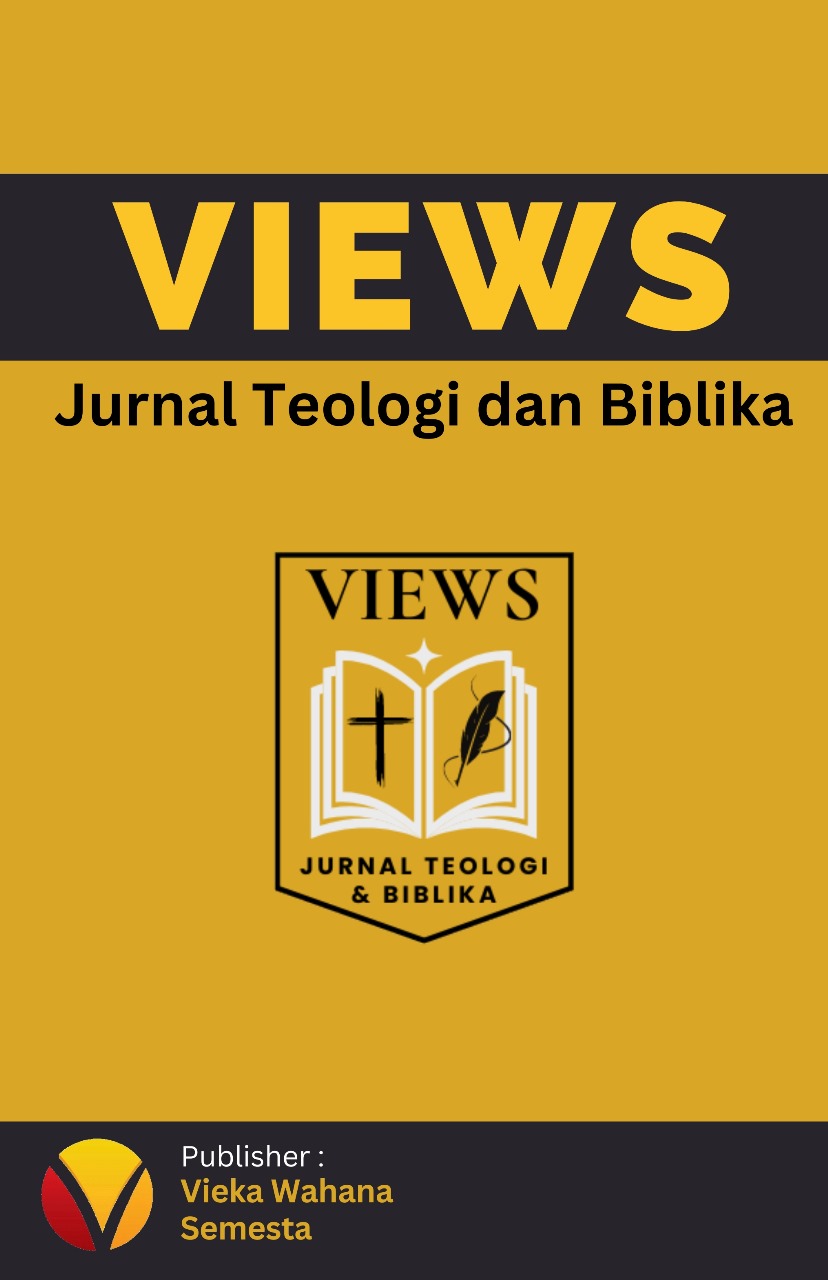Studi Eksegesis Terhadap Kolose 2:3 Tentang Ungkapan “Sebab Di Dalam Dialah Tersembunyi Segala Harta Hikmat Dan Pengetahuan”
DOI:
https://doi.org/10.63248/views.v2i2.49Keywords:
Hidden, Wisdom, KnowledgeAbstract
Abstract: Colossians 2:3 by examining the historical, literary context, as well as translating and evaluating the text from the original language. The Epistle to the Colossians, believed to have been written by Paul during his first imprisonment in Rome, aims to counter heresies and affirm the supremacy of Christ. In the literary context, Colossians 2:3 highlights that all wisdom and hidden knowledge are in Christ. Analysis of the Greek text shows that the word ἀπόκρυφοι means “hidden,” which is consistent with the New Living Translation (NLT) translation. The analysis of the Greek text shows that the word ἀπόκρυφοι means “hidden,” which is consistent with the New Living Translation (TB) and the Private Translation (TP), while the BIMK Translation renders the word as “uncovered,” which is not entirely appropriate. Word and grammatical analysis show that Christ is the ultimate source of all wisdom and knowledge. Interpretive help confirms that Christ is the center of God's previously hidden mysteries. The exegetical conclusion underlines that in Christ there is all the wisdom and knowledge necessary for a life in accordance with God's will. The relevance for today includes the importance of Christ as the ultimate source of knowledge and wisdom and the direction of a meaningful life in relationship with Him.
References
Bahasa, Tim Redaksi KBBI Pusat. Kamus Besar Bahasa Indonesia. IV. Jakarta: PT Gramedia Pustaka Utama, 2008.
Blegur, R. Konsep Harta Kepemilikan Dalam Perspektif Kerajaan Surga (Doctoral Dissertation, Seminari Alkitab Asia Tenggara Malang)., 2012.
D. Guthrie, J. A. Motyer, A. M. Stibbs, D. J. Wiseman. The New Bible Kommentary. Jakarta: Yayasan Komunikasi Bina Kasih, 2013.
D.A. Carson. Tafsiran Alkitab Abad Ke-21. Jakarta: Yayasan Komunikasi Bina Kasih, 1997.
D.A Carson & Douglas J. Moo. An Introduction to the New Tastement. malang: Gandum Mas, 2016.
Donald Gutrie. Pengantar Perjanjian Baru, Volume 2. Surabaya: Momentum, 2019.
Dr. Nocko Hosea Layantara. Pastoral Konseling Keluarga. Jakarta: ANDI, 2023.
Gulo, F. “Makna Teologis Mengumpulkan Harta Di Surga Berdasarkan Matius 6: 20.” Phronesis: Jurnal Teologi dan Misi 05, no. 02 (2022): 139–151.
Mattheuw Henry. Tafsiran Surat Galatia, Efesus, Filipi, Kolose, 1&2 Tesalonika, 1&2 Timotius, Titus, Filemon. Surabaya: Momentum, 2015.
Monike Hukubun. Nuhu-Met Sebagai Tubuh Kristus-Kosmis (Hermeneutik Kosmis Tentang Perjumpaan Makna Kolose 1: 15-20 Dengan Budaya Sasi Umum Di Kepulauan Kei-Maluku. Jakarta: PT Kanisius, 2023.
Raharjo, C. D., Rusgiyati, R., Ellyanto, D., & Widjaja, F. I. “Penginjilan Epafras Di Jemaat Kolose Dan Aplikasinya Bagi Misi Dan Penginjilan Dalam Masyarakat Plural.” Miktab: Jurnal Teologi dan Pelayanan Kristiani 02, no. 01 (2022): 1–20.
Robert G. Bratcher dan Eugene Albert Nida. Pedoman Penafsiran Alkitab (Surat-Surat Paulus Kepada Jemaat Di Kolose Dan Kepada Filemon),. Jakarta: Yayasan Karunia Bakti Budaya Indonesia, n.d.
Rusmanto, A., & Indarjono, R. “Studi Tafsir Surat-Surat Paulus Dan Implikasinya Bagi Mahasiswa Teologi.” EPIGNOSIS: Jurnal Pendidikan Kristiani dan Teologi 01, no. 02 (2022): 90–101.
Sianturi, R. P. Memaknai Pleroma (Kepenuhan Keallahan) Kristus Dalam Relasi Interreligius Di Indonesia Tafsiran Kontekstual Atas Kolose 2: 6-15., 2013.
Sidabutar, H. “Filsafat Ilmu Pendidikan Agama Kristen Dan Praksisnya Bagi Agama Kristen Masa Kini.” PEADA’: Jurnal Pendidikan Kristen 01, no. 02 (2020): 85–101.
Arti Kata Tersembunyi di Kamus Besar Bahasa Indonesia (KBBI) (lektur.id) Rabu, 29 Mei 2024
Downloads
Published
How to Cite
Issue
Section
License
Copyright (c) 2024 Licin Cermei Hulu

This work is licensed under a Creative Commons Attribution-ShareAlike 4.0 International License.
- Share — copy and redistribute the material in any medium or format
- Adapt — remix, transform, and build upon the material
- for any purpose, even commercially.
- The licensor cannot revoke these freedoms as long as you follow the license terms.
Under the following terms:
-
Attribution — You must give appropriate credit, provide a link to the license, and indicate if changes were made. You may do so in any reasonable manner, but not in any way that suggests the licensor endorses you or your use.
-
ShareAlike — If you remix, transform, or build upon the material, you must distribute your contributions under the same license as the original.
- No additional restrictions — You may not apply legal terms or technological measures that legally restrict others from doing anything the license permits.











